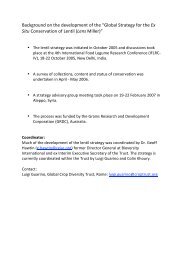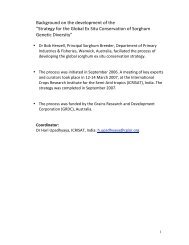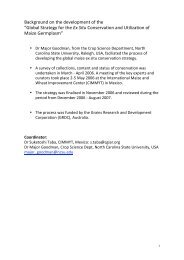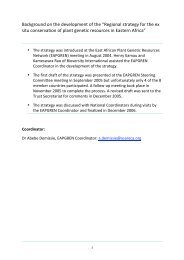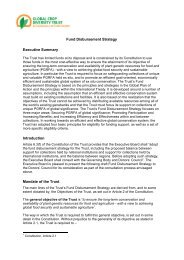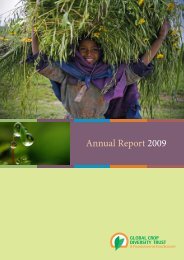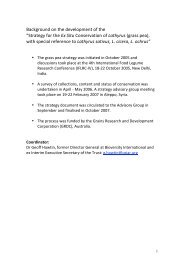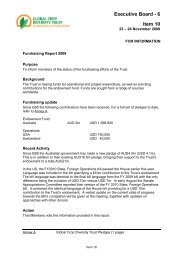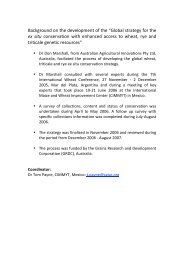Global Strategy for the Ex Situ Conservation of Potato - Global Crop ...
Global Strategy for the Ex Situ Conservation of Potato - Global Crop ...
Global Strategy for the Ex Situ Conservation of Potato - Global Crop ...
You also want an ePaper? Increase the reach of your titles
YUMPU automatically turns print PDFs into web optimized ePapers that Google loves.
! Solanum tuberosum spp. tuberosum is <strong>the</strong> most common potato and breeders prefer<br />
well-adapted germplasm or research material with interesting properties;<br />
! <strong>the</strong> number <strong>of</strong> collecting expeditions in <strong>the</strong> centre <strong>of</strong> diversity were very limited during<br />
<strong>the</strong> last 10 years when compared to earlier decades;<br />
! with <strong>the</strong> exception <strong>of</strong> some genetic gaps most wild material had been collected earlier<br />
on.<br />
Twenty-one out <strong>of</strong> 23 potato curators indicated that <strong>the</strong>ir collections exhibit some gaps and<br />
most intend to organise future collecting missions (in <strong>the</strong> centre <strong>of</strong> diversity and/or <strong>the</strong> own<br />
country) or to introduce germplasm from o<strong>the</strong>r genebanks to fill <strong>the</strong>se gaps.<br />
It appeared that 30 wild species approximately are not yet represented in <strong>the</strong> collections and<br />
may still need to be collected. In addition, <strong>for</strong> ano<strong>the</strong>r 25 wild species, only less than three<br />
accessions are present in <strong>the</strong> collections (see Table 3, Annex 5). Hijmans et al. (2002)<br />
present in <strong>the</strong> “Atlas <strong>of</strong> Wild <strong>Potato</strong>es” in<strong>for</strong>mation on <strong>the</strong> eco-geographic distribution <strong>of</strong> wild<br />
relatives <strong>of</strong> potato in <strong>the</strong> centre <strong>of</strong> diversity.<br />
In line with <strong>the</strong> in<strong>for</strong>mation provided above, <strong>the</strong> response to <strong>the</strong> question on <strong>the</strong> expected<br />
increase <strong>of</strong> collection size over <strong>the</strong> next five years was as follows (Table 3, Annex 4):<br />
! Same size: 6 collections<br />
! 5-10 % increase: 12 collections<br />
! 20 % increase: 5 collections<br />
Several potato curators stated that whereas <strong>the</strong>y plan to extend <strong>the</strong> collections with new<br />
germplasm to fill remaining gaps <strong>the</strong>y consider simultaneous rationalization <strong>of</strong> part <strong>of</strong> <strong>the</strong>ir<br />
collections.<br />
5.4.2 Regeneration<br />
Regeneration <strong>of</strong> wild relatives <strong>of</strong> potato<br />
To maintain accessions <strong>of</strong> wild relatives <strong>of</strong> potato, ten genebanks regenerate <strong>the</strong> accessions<br />
as populations and produce true seed <strong>for</strong> each accession, whereas five genebanks with<br />
relatively smaller collections maintain <strong>the</strong>se wild species vegetatively by means <strong>of</strong> in vitro<br />
conservation (Table 4.1, Annex 4). Most genebanks producing true seed base <strong>the</strong><br />
regeneration on 10 to 20 plants per population, three are using 20 to 30 plants and two less<br />
than 10 plants only. The last option results in a high probability to lose genes present in <strong>the</strong><br />
population due to genetic drift.<br />
The joint annual regeneration capacity <strong>of</strong> wild species maintained in <strong>the</strong> <strong>for</strong>m <strong>of</strong> true seed is<br />
approximately 1,400 accessions. In addition, 930 accessions are maintained in vitro. Based<br />
on <strong>the</strong> provided in<strong>for</strong>mation (data <strong>for</strong> <strong>the</strong> percentage <strong>of</strong> accessions that needs urgent<br />
regeneration), it is estimated that conservation <strong>of</strong> 3,600 accessions <strong>of</strong> wild species<br />
approximately out <strong>of</strong> a total <strong>of</strong> 17,000 is threatened. The number <strong>of</strong> threatened unique<br />
accessions is probably much lower (< 2000 accessions), assuming a substantial duplication<br />
rate between collections.<br />
Regeneration <strong>of</strong> native cultivars<br />
Seventeen genebanks conserve native cultivars <strong>of</strong> potato in <strong>the</strong>ir collections. Most <strong>of</strong> <strong>the</strong>se<br />
genebanks (12) maintain <strong>the</strong>se native cultivars vegetatively (in <strong>the</strong> <strong>for</strong>m <strong>of</strong> tubers in <strong>the</strong> field<br />
or in vitro). In addition, five collections outside Latin America maintain this type <strong>of</strong> germplasm<br />
in <strong>the</strong> <strong>for</strong>m <strong>of</strong> populations. The latter method conserves <strong>the</strong> genes in <strong>the</strong> population but does<br />
not maintain <strong>the</strong> original genotype (cultivar). A few genebanks use both methods (Table 4.2,<br />
Annex 4).<br />
In general, 15-30 tubers are used <strong>for</strong> field rejuvenation <strong>of</strong> tuber material mostly obtained from<br />
10-20 plants. For in vitro conservation maintenance <strong>of</strong> 10 plantlets is <strong>the</strong> most common<br />
practice. The annual regeneration capacity <strong>of</strong> native cultivars is c. 5000 accessions (mainly<br />
through vegetative propagation; only 500 accessions are maintained by true seeds).<br />
12




